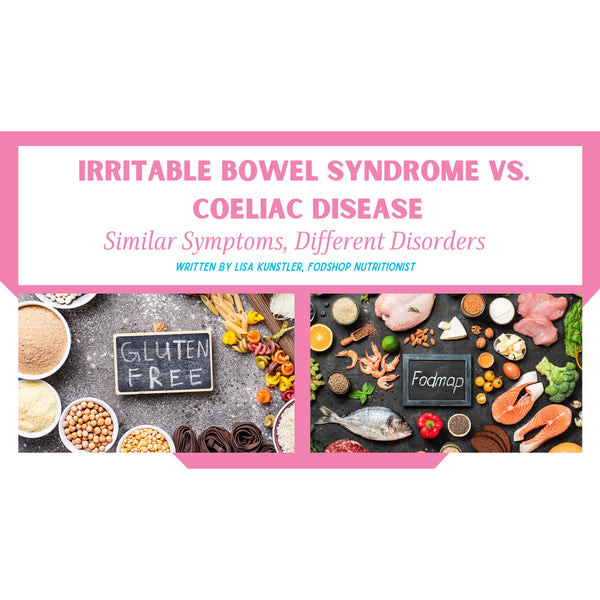- Ph: +61 435 003 412
- operations@fodshopper.com.au
"Organic Orange" has been added to your cart. View cart
"Organic Orange" has been added to your cart. View cart

As we transition from Coeliac Awareness Month in March and now commence Irritable Bowel Syndrome (IBS) Awareness Month in April, it is important that, as a crucial IBS support resource, we address the differences between the two conditions.
Coeliac Disease (CD) is frequently confused for IBS, and many people make the mistake of 'self-diagnosing' or assuming they may have either condition. This is because many of the same gastrointestinal symptoms overlap, making it very difficult for sufferers of gut symptoms to know exactly what has caused them to begin with.
The symptoms of diarrhoea, bloating, fatigue, abdominal pain & flatulence may also be indicative of other gut disorders, like Inflammatory Bowel Disease (IBD), and/or various other diseases, some of which can be more sinister if they coincide with other known risk factors.
IBS is a considered a Functional Gastrointestinal Disorder (FGID), impacting up to 15% of the Western population, frequently diagnosed in gastroenterologists' daily practice. (1)
According to the International Foundation for Gastrointestinal Disorders, Inc. (IFFGD), up to 20-40% of visits to gastroenterologists are due to IBS symptoms, include bloating, constipation, excessive flatulence, abdominal pain and diarrhoea. (2, 3)
The onset of these symptoms can be motivated by consumption of foods high in FODMAPs (Fermentable Oligosaccharides, Disaccharides, Monosaccharides and Polyols). (3)
In the coming weeks, we will be discussing the FODMAP diet in greater detail.
IBS is diagnosed by a doctor via the Rome IV criteria. The criteria include frequent abdominal pain that can occur alongside diarrhoea and constipation and/or alternating bowel habits. (4)
Within the criteria, three predominant subtypes exist:
"IBS with constipation (IBS-C), IBS with diarrhoea (IBS-D) and mixed IBS (IBS-M)". (5)
IBS-I can develop after infectious illness identified by two or more of either "fever, vomiting, diarrhoea, or positive stool culture". (5)
More information on the Rome IV diagnosis criteria for IBS is available HERE.
Unfortunately for many IBS patients, the disorder is diagnosed based on "exclusion criteria", meaning that IBS is what is classified as the diagnosis once various other more readily-detected conditions, like Coeliac Disease, have been ruled out of the medical assessment process.
If you think you might have symptoms of IBS, it is best to contact your doctor followed by an Accredited Practising Dietitian to help manage your symptoms via dietary modification, especially if you plan to modify/are already modifying your diet in response to known, or perceived dietary triggers.
The low FODMAP diet is clinically proven to be the most effective dietary intervention for the treatment of IBS and IBS-type symptoms, with up to 86% of sufferers experiencing relief and improved quality of life. (3, 6)
If a low FODMAP diet is recommended to you, a three-phase process will be conducted to help you ascertain your dietary triggers:
Alleviate symptoms by swapping out high FODMAP foods for low FODMAP alternatives. (7) The goal is to pinpoint high FODMAP dietary triggers and eliminate them from the diet for a 6-8 week period. This phase is strict and should not be continued in the long term.
Continue the low FODMAP diet whilst adding challenges of high FODMAP foods to determine tolerance to such. This will determine individual FODMAP tolerance thresholds to specific high FODMAP foods. (7)
In order to achieve long term symptom relief, well tolerated foods can now be reintroduced and poorly tolerated ones should be limited. (7)
More information on the low FODMAP diet in a three step process is available HERE. Note that alternative therapies such as gut directed hypnotherapy, yoga and light exercise and certain medications may also be beneficial. These can also be explored HERE.
In the coming weeks, we will be discussing the role of the low FODMAP diet in IBS symptom management in more depth.
Coeliac Disease (CD) is an autoimmune disease whereby the immune system attacks itself. The consumption of gluten triggers an immune response, causing damage to the lining of the small intestine. (8)
The disease impacts roughly 1 in 100 people around the world, and can develop at any age after commencement of gluten consumption in either foods or medicine. (8)
The Rome IV Criteria is used for diagnosing IBS however, many symptoms including diarrhoea, distension and abdominal cramps are however, also present in CD patients. (1)
CD is diagnosed via a gluten challenge, blood tests and a bowel biopsy. (8) Blood tests are conducted to screen for CD and must be followed by a small bowel biopsy to confirm the diagnosis. (9) This will involve a 10 minute gastroscopy procedure, where small samples are taken and tested under the microscope to determine CD. (8)
The gluten challenge should only be conducted after being tested for CD.
A gluten challenge involves consumption of four slices of wheat bread each day for adults (two slices for children). (9) There is currently no consensus as to the length of time the challenge should be carried out however, Coeliac Australia recommend "including more gluten for a longer period of time to guarantee a correct diagnosis". (9)
When an individual with CD consumes gluten, the body reacts with an immune response that attacks the villi, tiny finger-like projections lining the small intestine. (8)
The small intestine is responsible for absorbing nutrients from digested food. However, a damaged lining becomes flattened, reducing nutrient absorption, and consequently causing nutritional deficiencies. (8)
One of the key minerals malabsorbed is iron, which can cause Iron Deficiency Anaemia (IDA) in the long term if left untreated. Symptoms of IDA including pale/yellow skin, fatigue, shortness of breath or chest pain, weakness or rapid heartbeat. (10)
CD patients remaining undiagnosed and untreated are at risk of serious autoimmune diseases (such as Type I Diabetes and Multiple Sclerosis), infertility, osteoporosis, neurological conditions (such as epilepsy and migraines) anaemia, dermatitis herpetiformis (itchy skin rash), heart disease, intestinal cancers and more. (7)
To date, there is no cure for CD. The best treatment is a life long, gluten-free (GF) diet. (8, 11) This excludes barley, wheat, rye, oats & triticale, and food products containing traces of such. (8)
Examples include beer, bread, and pastas. Even small quantities of gluten, such as toaster crumbs may cause intestinal damage. (8) Safe foods for consumption include naturally GF foods, products labelled 'GF', products including the Coeliac Australia Endorsement Logo and products that are suitable based on their ingredients and having been produced on a gluten free production line. (9)
In one study conducted in 2014, after a year of following a gluten-free diet, asymptomatic CD patients found that gastrointestinal symptoms, anxiety and perception of their own health had improved, compared with patients who did not follow the diet. (11)
If you are experiencing uncomfortable gut symptoms, it is best to contact your doctor.
Many people living in our communities around the world remain undiagnosed and untreated for CD and/or IBS, with misdiagnosis and/or self-diagnosis being very common.
It is important to determine a concrete diagnosis in order to rule out any other conditions, which first starts with a visit to your doctor.
Your practitioner should make a referral to a suitably trained & qualified FODMAP and Coeliac Disease expert Accredited Practising Dietitian, as such nutrition practitioners will determine the most appropriate nutrition intervention tailored to your unique personal presentation.
1. Shahbazkhani B, Forootan M, Merat S, Akbari MR, Nasserimoghadam S, Vahedi H, et al. Coeliac disease presenting with symptoms of irritable bowel syndrome. Aliment Pharmacol Ther [Internet]. 2003;18(2):231–5. Available from: http://dx.doi.org/10.1046/j.1365-2036.2003.01666.
2. International Foundation for Gastrointestinal Disorders, Inc. (IFFGD), Statistics - About IBS (2022): https://aboutibs.org/what-is-ibs/facts-about-ibs/statistics/.
3. Barrett JS. How to institute the low-FODMAP diet: How to institute the low-FODMAP diet. J Gastroenterol Hepatol [Internet]. 2017 [cited 2022 Mar 17];32 Suppl 1:8–10. Available from: https://pubmed.ncbi.nlm.nih.gov/28244669/
4. Rome IV Criteria - Rome Foundation [Internet]. Rome Foundation. 2022 [cited 17 March 2022]. Available from: https://theromefoundation.org/rome-iv/rome-iv-criteria/
5. Saha L. Irritable bowel syndrome: pathogenesis, diagnosis, treatment, and evidence-based medicine. World J Gastroenterol [Internet]. 2014 [cited 2022 Mar 21];20(22):6759–73. Available from: https://www.ncbi.nlm.nih.gov/labs/pmc/articles/PMC4051916/
6. Nanayakkara WS, Skidmore PM, O'Brien L, Wilkinson TJ, Gearry RB. (2016). Efficacy of the low FODMAP diet for treating irritable bowel syndrome: the evidence to date, Clin Exp Gastroenterol. Volume 9, Pages 131-142. doi:10.2147/CEG.S86798, https://www.ncbi.nlm.nih.gov/pmc/articles/PMC4918736/.
7. Treating ibs with a 3-step fodmap Diet [Internet]. Monashfodmap.com. [cited 2022 Mar 17]. Available from: https://www.monashfodmap.com/documents/5/3-step_FODMAP_Diet.pdf
8. What is celiac disease? [Internet]. Celiac Disease Foundation. [cited 2022Mar21]. Available from: https://celiac.org/about-celiac-disease/what-is-celiac-disease/#:~:text=Untreated%20celiac%20disease%20can%20lead,conditions%20like%20epilepsy%20and%20migraines%2C
9. Coeliac Australia. [cited 2022Mar21]. Available from: https://www.coeliac.org.au/s/the-gluten-free-diet
10. Iron-deficiency anemia [Internet]. Hematology.org. [cited 2022Mar21]. Available from: https://www.hematology.org/education/patients/anemia/iron-deficiency
11. Catassi C, Fasano A. Coeliac disease. The debate on coeliac disease screening--are we there yet?: Coeliac disease. Nat Rev Gastroenterol Hepatol [Internet]. 2014 [cited 2022 Mar 21];11(8):457–8. Available from: https://www.nature.com/articles/nrgastro.2014.119

Leave a reply